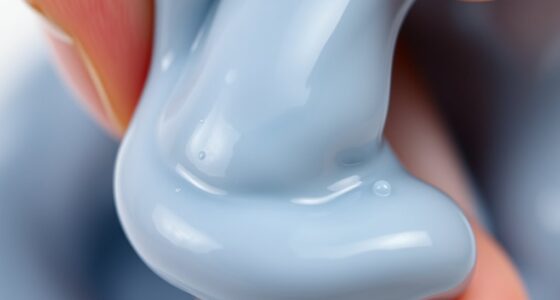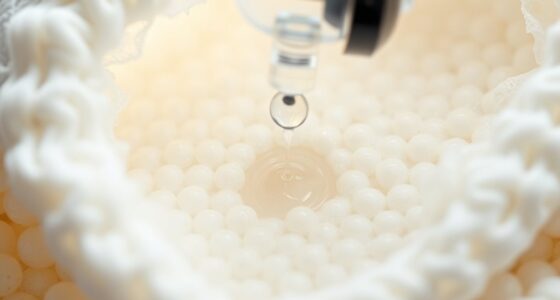When you light a candle, the heat melts the wax, which is usually paraffin, soy, or beeswax, fueling the flame. The wick draws liquid wax upward through capillary action, supporting combustion. As the wax vaporizes, it reacts with oxygen, producing heat, light, and byproducts like CO₂ and water. Understanding how wax, wicks, and chemistry work together helps you see what makes a candle burn cleanly and safely—keep exploring to learn more.
Key Takeaways
- Candle burning begins with ignition of the wick, which heats the wax, causing it to melt and vaporize for continuous fuel supply.
- Wicks draw liquid wax via capillary action, supporting stable combustion and influencing flame size and soot production.
- Vaporized hydrocarbons react with oxygen during combustion, producing heat, light, CO₂, H₂O, and potential soot or pollutants.
- Types of wax (paraffin, soy, beeswax) affect combustion emissions, with natural options generally emitting fewer harmful substances.
- Proper ventilation and appropriate wick selection help reduce soot, toxic fumes, and environmental impact of candle burning.
The Composition of Candle Materials
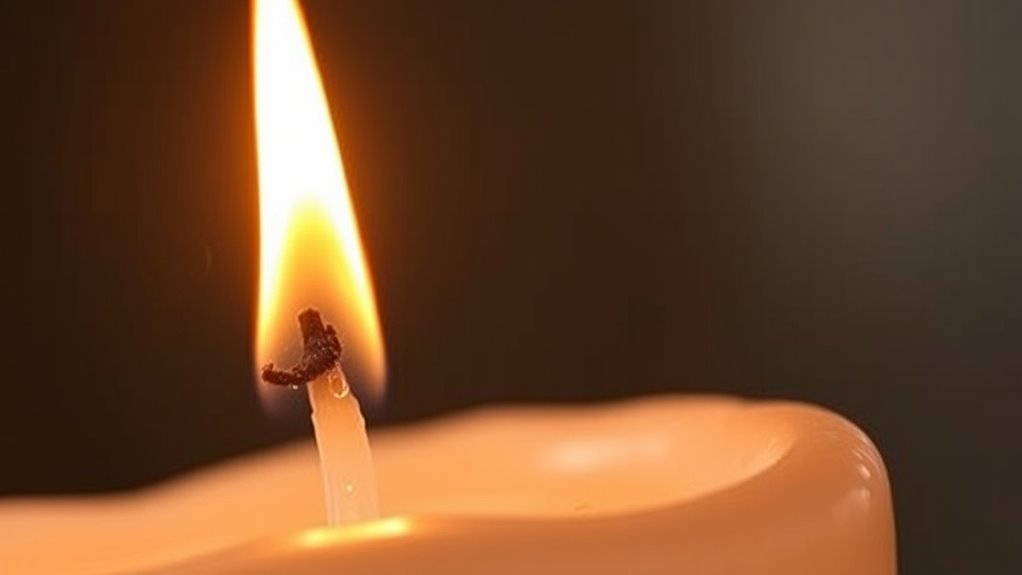
Candle materials are composed of several essential components that work together to produce a functional and attractive product. The main ingredient is wax, which acts as the fuel for the flame. You can choose from various types like paraffin, soy, beeswax, palm wax, and blended waxes, each with different properties. Wax is solid at room temperature; it melts when heated, providing a continuous fuel source for the flame. Paraffin, derived from petroleum, is affordable and versatile, while soy wax, made from soybean oil, is eco-friendly and burns clean. Beeswax, produced by honeybees, offers a natural scent and long-lasting burn. The physical qualities of wax, such as melting point and hardness, vary depending on the type. Besides wax, candles also contain wicks, fragrances, colorants, and containers, all contributing to the candle’s function and appearance. Understanding the chemical composition of different waxes can help in selecting the right material for specific candle-making purposes.
The Process of Candle Ignition and Melting

When you light a candle, the process starts with applying a heat source, like a match or lighter, to the wick. The flame heats the nearby wax, causing it to melt. Capillary action draws the liquid wax up the wick, delivering it to the flame. As the wax reaches the flame, it vaporizes into gaseous hydrocarbons, which then mix with oxygen from the air. The high temperature (over 500°C) at the flame’s base facilitates this vaporization. These vaporized hydrocarbons react with oxygen, producing heat, light, carbon dioxide, and water vapor. The heat from the flame melts more wax, maintaining combustion. A stable, self-sustaining flame forms when the wax vaporization and oxygen supply are balanced, ensuring continuous burning until the wax is exhausted. Proper airflow and combustion efficiency are essential for a clean and steady burn.
How Wicks Support Combustion
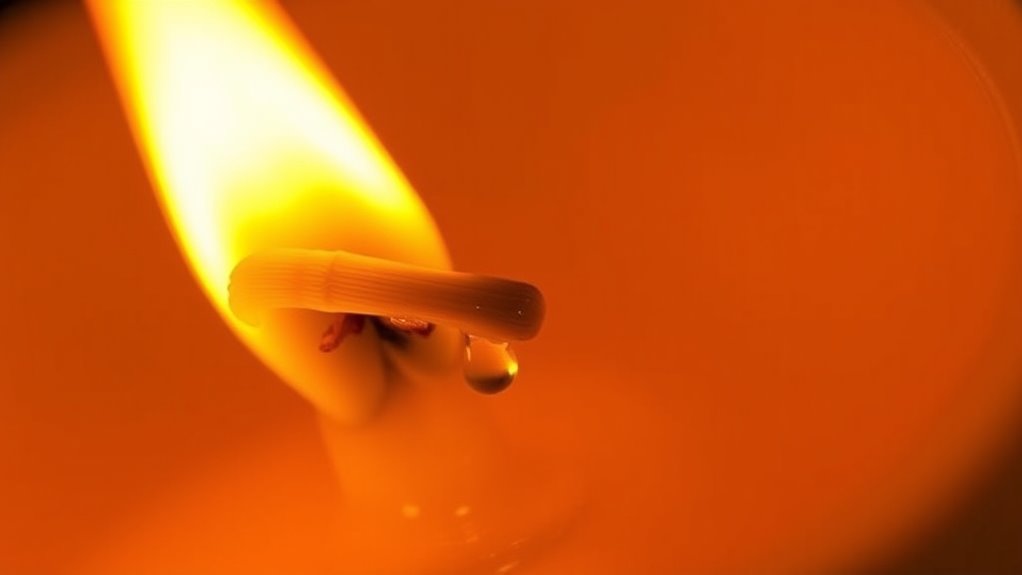
Wicks play a crucial role in supporting combustion by delivering a steady flow of liquid wax to the flame. Made from materials like cotton or paper, they use capillary action to draw melted wax upward. This process ensures a continuous fuel supply, which is necessary for maintaining the flame. The size and material of the wick directly influence burn efficiency and stability; a wick that’s too large or small can cause uneven burning or soot. The wick also affects the vaporization of wax, impacting heat and light production. Proper wick performance stabilizes the flame, prevents soot buildup, and promotes complete combustion. By consistently supplying wax, the wick helps sustain the flame and optimize the candle’s overall burning process. Capillary action is the key mechanism that allows the wick to draw up the wax effectively, ensuring a smooth and steady burn. Additionally, selecting the appropriate wick type can help control flame size and reduce soot production for a cleaner burn.
The Chemistry Behind Burning Candles
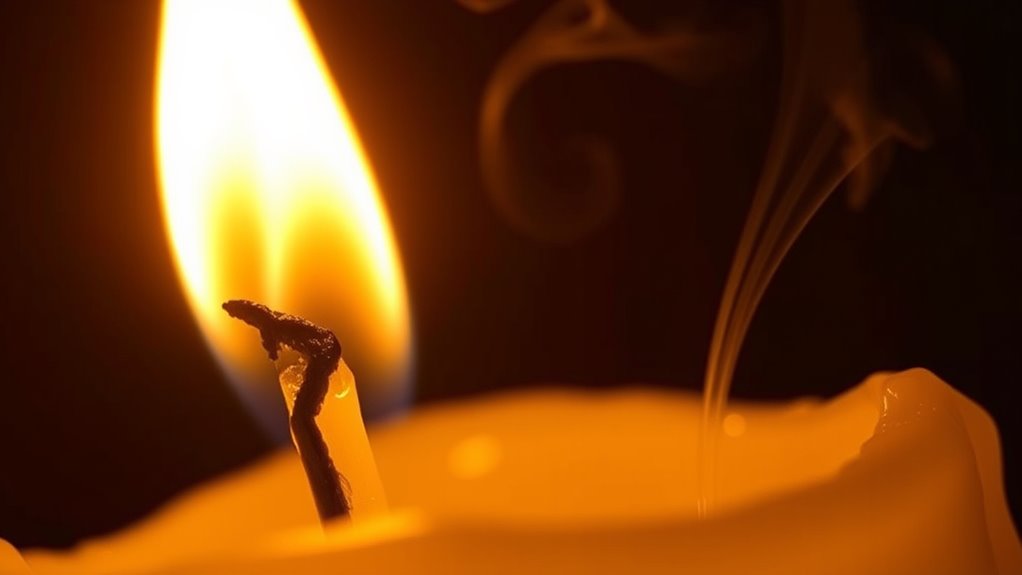
At the core of candle burning is a chemical reaction between vaporized hydrocarbons from the wax and oxygen in the air. When the flame heats the wax, it melts into liquid, which is drawn up through the wick by capillary action. The heat causes the liquid wax to vaporize into gaseous hydrocarbons, primarily long-chain alkanes like paraffin. These vaporized molecules react with oxygen during combustion, breaking down into carbon dioxide and water vapor while releasing heat and light. This process involves initial cracking of wax molecules into smaller fragments, which then oxidize. The energy released transforms chemical energy into heat and radiant light. As a result, your candle produces byproducts like CO₂, H₂O, soot, and sometimes trace gases, following typical hydrocarbon combustion chemistry. Additionally, understanding the importance of maximizing space and organization can help maintain a safe environment for candle use by reducing clutter and potential fire hazards.
Environmental and Safety Considerations
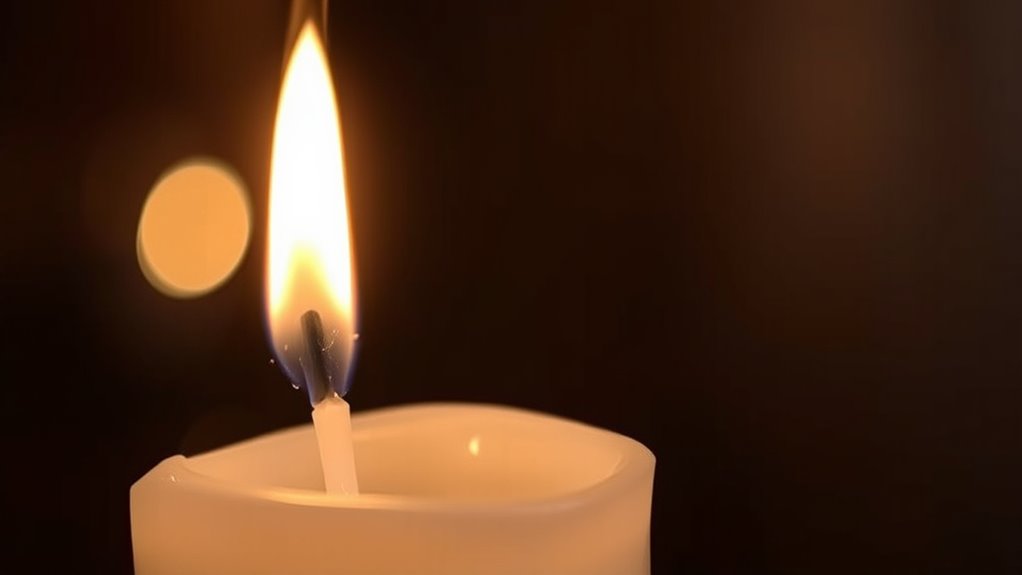
Have you ever considered how the type of candle you choose impacts the environment and your health? Burning paraffin candles releases toxic substances like formaldehyde and polyaromatic hydrocarbons, which harm both the planet and your well-being.
Natural waxes such as beeswax and soy produce fewer emissions, making them more eco-friendly options. Synthetic waxes like gel can emit harmful fumes and pose toxicity risks during use.
Candle combustion also releases hydrocarbons like benzene and toluene, which irritate your eyes, throat, and skin, and may cause long-term health issues. Poor ventilation increases these risks.
Additionally, candles with synthetic fragrances or metal wicks can release endocrine disruptors and carcinogens.
To reduce hazards, choose natural waxes, use proper ventilation, and burn candles in open, well-ventilated areas. Color accuracy impacts overall image quality and should be considered when selecting a home cinema projector.
Frequently Asked Questions
How Does Candle Color Influence Combustion and Emission Quality?
You might wonder if candle color affects combustion and emissions. In reality, color has minimal impact.
Additives and dyes are usually combustible but don’t substantially change burn rate or emission quality.
Factors like wax type, wick size, and environmental conditions play a bigger role.
Can Candle Additives Affect the Rate of Burning or Soot Production?
So, you’re wondering if candle additives can change how fast your candle burns or how much soot it produces? Well, they definitely can! Additives like stearic acid slow down the burn rate and can make combustion cleaner.
They tweak melting points and wax hardness, meaning your candle might last longer and emit less soot. Basically, with the right additives, you get a longer, cleaner glow—less smoke, more glow.
What Are the Differences in Combustion Efficiency Between Various Wax Types?
When comparing wax types, you’ll notice differences in combustion efficiency. Paraffin burns hotter and brighter but produces more soot, meaning less efficient combustion overall.
Soy wax burns cooler and slower, leading to longer, cleaner burns but slightly less bright.
Beeswax and coconut wax burn at high or moderate temperatures with cleaner emissions, offering better efficiency.
Your choice depends on whether you prioritize brightness, burn time, or cleaner combustion.
How Do Wick Materials Impact Flame Stability and Emission Levels?
Think of your wick as the heartbeat of your candle—its material directly influences flame stability and emissions. Cotton and hemp wicks burn clean and steady, reducing soot, while synthetic fibers may produce more smoke but stabilize the flame.
Metal-core wicks keep shape and consistency, and proper maintenance guarantees ideal burn. Your choice and care of wick material make all the difference in a safe, steady, and eco-friendly candle experience.
What Advancements Are Being Made for More Environmentally Friendly Candles?
You’ll see advancements in making candles more eco-friendly, like switching to natural waxes such as soy, beeswax, and coconut wax, which burn cleaner and are biodegradable.
Companies are developing reusable containers and biodegradable packaging to reduce waste. Refill and circular economy models encourage sustainable use.
Additionally, organic, lead-free wicks and natural fibers improve combustion and air quality. These innovations help lower environmental impact while providing greener options for consumers.
Conclusion
Now that you understand the science behind candle burning, you can appreciate each flicker of light as a tiny miracle of chemistry. From wax to wick, every element plays a vital role in creating that warm glow. With this knowledge, you’ll see candles in a new light—no pun intended—realizing they’re a delicate balance of science and art. Light up your world wisely, knowing you’re holding a miniature universe of combustion in your hands.


